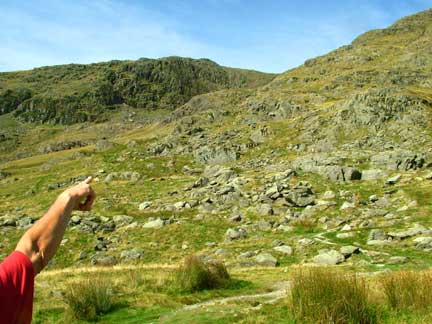After our filling breakfast and packing our lunch for the day, we collected our boots from the "boot room." Each HF house, that I have been in, has a boot room for drying hiking boots. It is often very necessary in England.

In addition to the boots, the room usually contains the furnace for the buildings, lots of newspapers to stuff in wet boots to help them dry, and shoe polish for those who want to look spiffy and protect their boots as much as possible. I always try to use both if I have the energy at the end of the walks.
On this day, we walked part way down the hill to a wider spot in the road where we could board a bus without stopping traffic. The bus took us to Ambleside where all three hikes started. The harder hike, and the medium hike, started up hill beside a stream and we all stopped to view the waterfalls of Stock Ghyll Force. Compared to the waterfalls on the Niagara Escarpment where I come from these days, the waterfalls were not very big but they were quite beautiful.

After passing the waterfalls, we climbed steadily up hill towards the third highest pub in England where we did not stop much to the dismay of several of the walkers. However, we had the major climb of the day ahead of us.

You can see the trail just to the centre right of the photo and our leader is pointing to where the trail takes us up and up and into the scree.
There was mention of a chimney climb but we did not have to try that technical bit of the climb as a trail did lead around that narrow steep ascent. I think it might have been fun but we were high enough that we looked down on an airplane that was passing through just before we reached the toughest part of the climb. Note the pub with the car park at the bottom of the photo. Can you count the cars? Neither can I. It's too far down.

Our lunch stop afforded some wonderful view.

After lunch, we walked part way down one mountainside and then back up to another peak before starting a long ridge walk back down to Ambleside. On the way, I stopped to take several photos of the stonewalls. The one below is probably the most representative of the amazing walls and the places they were built. Those slopes are difficult to walk let alone walk with rocks to balance on a dry stonewall. All the dry stonewalls are built without mortar and many of the walls were over 5 feet tall although the "standard" was 4 feet 6 inches (1.37 m) tall. The bases of the walls were between 28 and 32 inches (710 & 810 mm) and they taper in slightly as they are built. The copestones, or top stones, are usually upright to 1) add weight that helps hold the wall together, 2) tie the two sides together, and 3) to add some decoration. (Yes, I bought a book on dry stonewall construction.)

Below is one more stonewall photo showing the wall that the trail followed down the mountain all the way to Ambleside. You can see Ambleside in the distance near the water.

Here is the GPS account of our walk.

5 comments:
Really loving this series of posts! I almost feel as though I was there.
I definitely want a boot room for my next house!
I am glad you like the series. It's taking a lot more time than my usual quick notes.
Oh my! Your pictures and narratives are just wonderful. My gosh, you two have seen some really wonderful sights.
Hiking and travelling like we have done was beyond my wildest dreams as a young person. I feel lucky to have had the opportunity to do these and other travels. I hope I get a chance to do a few more before I run out of time, and money.
That's a wonderful post. I wish we had a little vertical drama here, and I could use a few more rocks, too.
Post a Comment